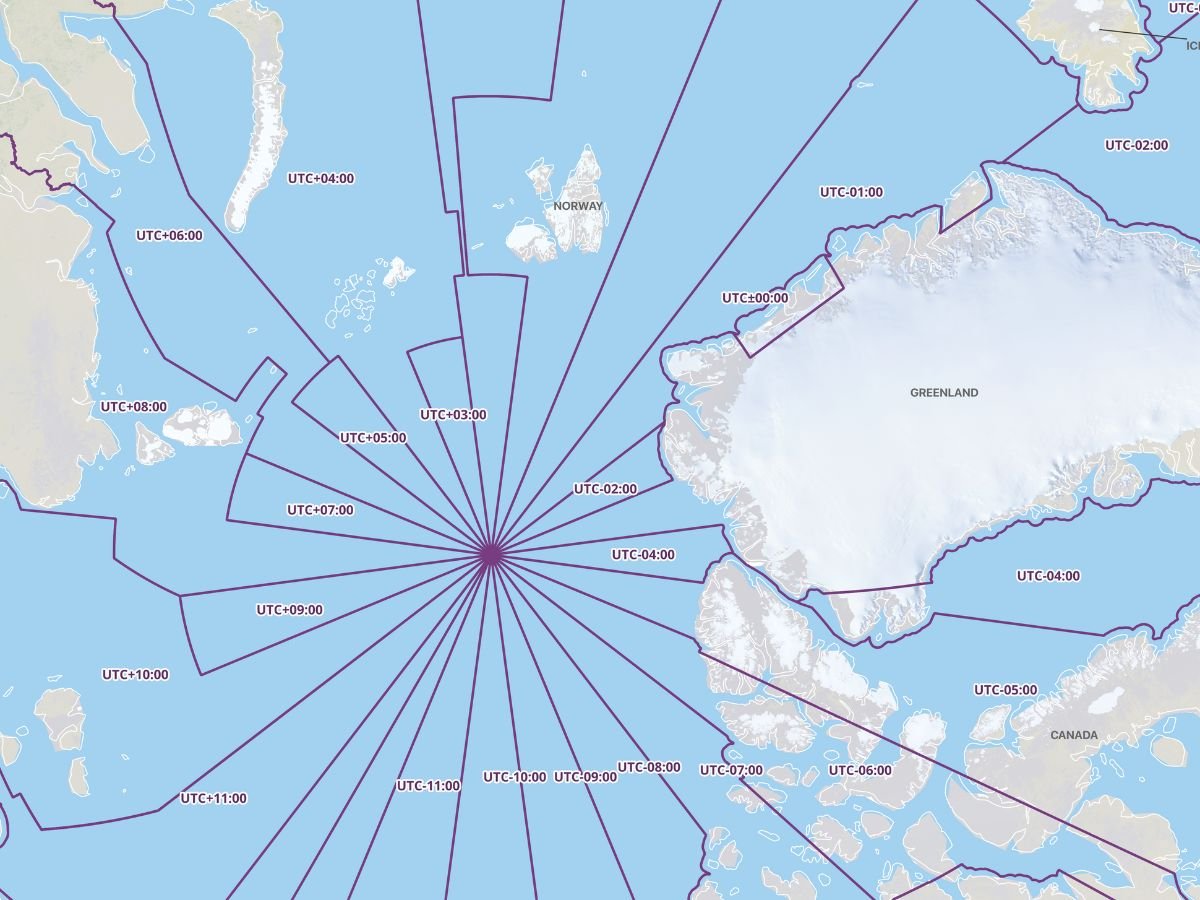A time zone is a region or area that observes the same standard time. Time zones were established to help standardize time across the world.
Before the creation of standardized time zones, cities and towns around the world followed their local solar time, leading to inconsistencies and confusion in scheduling and communication.
Coordinated Universal Time (UTC) was adopted as the primary standard for regulating time worldwide. The time zone at the Prime Meridian (0°) was established as UTC-0.
How are time zones divided?
The world is divided longitudinally into time zones. There are 360° degrees of longitude and 24 hours in each day.
Dividing the number of degrees of longitude by the number of hours in each days means that each hour difference in time is roughly 15 degrees apart (360 degrees/ 24 hours).

How time zones are divided
The start of the world’s time zones is spread 7.5° to the east and west of the Prime Meridian. While each 15° segment of longitude is roughly equal to one hour, the actual timezones are not uniform.
This map of Europe demonstrates how the actual timezones depart from straddling 15° degree longitude segments. The timezones follow country borders instead of lines of longitude.

How many time zones are there in the world?
Due to some countries having half hour time zones, there are more than 24 times zones in the world.
Most countries, especially the smaller ones, have only one time zone. There are 23 countries with at least two time zones.
Since all lines of longitude coverage at the North and South Poles, Antarctica and the Arctic technically have all time zones.

The Starting Point of Time Zones
The starting point at which Coordinated Universal Time (UTC) starts is the Prime Meridian (zero degrees longitude).

International Date Line
The International Date Line (IDL), located at or near 180 degrees longitude delineates one day from the next; time incrementally advances as one travels west of the IDL.

The International Date Line deviates from 180 degrees longitude in order to keep islands and other landmasses in the same time zones as the country of jurisdiction.
For example, the International Date Line passed between the Commander Islands (part of Russia) and Attu Island (part of the United States).

France Has the Most Time Zones
The country with the most time zones is France, mostly due to its various territories around the world. These time zones are:
- UTC−10:00 — most of French Polynesia
- UTC−09:30 — Marquesas Islands
- UTC−09:00 — Gambier Islands
- UTC−08:00 — Clipperton Island
- UTC−04:00 (AST) — Guadeloupe, Martinique, Saint Barthelemy, Saint Martin
- UTC−03:00 (PMST) — French Guiana, Saint Pierre and Miquelon
- UTC+01:00 (CET) — Metropolitan France
- UTC+03:00 — Mayotte
- UTC+04:00 — Réunion
- UTC+05:00 — Kerguelen Islands, Crozet Islands
- UTC+11:00 — New Caledonia
- UTC+12:00 — Wallis and Futuna

Countries With the Second Most Amount of Time Zones
The United States and Russia are tied for second place with eleven time zones each.
The United States has the following time zones:
- UTC−12:00 (unofficial) — Baker Island and Howland Island
- UTC−11:00 (ST) — American Samoa, Jarvis Island, Kingman Reef, Midway Atoll and Palmyra Atoll
- UTC−10:00 (HAT) — Hawaii, most of the Aleutian Islands, and Johnston Atoll
- UTC−09:00 (AKT) — most of the state of Alaska
- UTC−08:00 (PT) — the states on the Pacific coast plus Nevada and parts of Idaho
- UTC−07:00 (MT) — Arizona, Colorado, Montana, New Mexico, Utah, Wyoming, parts of Idaho, Kansas, Nebraska, Oregon, North Dakota, South Dakota, and Texas
- UTC−06:00 (CT) — Gulf Coast, Tennessee Valley, U.S. Interior Highlands, Great Plains, and most of Texas
- UTC−05:00 (ET) — the states on the Atlantic coast, the eastern two-thirds of the Ohio Valley, most of Michigan, Bajo Nuevo Bank, Navassa Island and Serranilla Bank
- UTC−04:00 (AT) — Puerto Rico, the U.S. Virgin Islands and Palmer Station
- UTC+10:00 (ChT) — Guam and the Northern Mariana Islands
- UTC+12:00 (unofficial) — Wake Island, McMurdo Station, and Amundsen–Scott South Pole Station

Russia has the following time zones:
- UTC+02:00 (Kaliningrad Time) — Kaliningrad Oblast
- UTC+03:00 (Moscow Time) — Most of European Russia and all railroads throughout Russia
- UTC+04:00 (Samara Time) — Samara Oblast, Udmurtia
- UTC+05:00 (Yekaterinburg Time) — Bashkortostan, Chelyabinsk Oblast, Khanty–Mansia, Kurgan Oblast, Orenburg Oblast, Perm Krai, Sverdlovsk Oblast, Tyumen Oblast, and Yamalia
- UTC+06:00 (Omsk Time) — Altai Krai, Altai Republic, Kemerovo Oblast, Novosibirsk Oblast, Omsk Oblast and Tomsk Oblast
- UTC+07:00 (Krasnoyarsk Time) — Khakassia, Krasnoyarsk Krai and Tuva
- UTC+08:00 (Irkutsk Time) — Buryatia, Zabaykalsky Krai and Irkutsk Oblast
- UTC+09:00 (Yakutsk Time) — Amur Oblast and western Sakha Republic
- UTC+10:00 (Vladivostok Time) — The Jewish Autonomous Oblast, Khabarovsk Krai, Magadan Oblast, Primorsky Krai, central Sakha Republic and Sakhalin Island
- UTC+11:00 (Srednekolymsk Time) — eastern Sakha and Kuril Islands
- UTC+12:00 (Kamchatka Time) — Chukotka and Kamchatka Krai
Time Zones in Antarctica
Theoretically, all time zones converge in Antarctica. Antarctica is a continent with no part-time residents but has several research stations located on it.
In practice, the time zone used by a research station is usually based on territorial claims or logistics. For example, McMurdo Station and Amundsen–Scott South Pole Station use New Zealand time to align with the supply base in Christchurch.
Map of Time Zones in the World

This article was originally written on March 18, 2016 and has since been updated.
